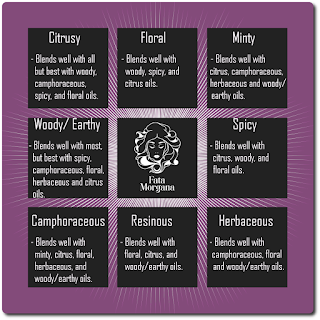Carrier Oils
Smells
Floral:
Minty:
Citrusy:
Citrusy oils often have what can be described as a bright, fresh and clean smell - which makes them well loved in cleaning products and deodorising blends. They are also excellent to use when you need to improve concentration levels, and boosting one's mood is necessary and they have an uplifting and energising effect.
Many citrus oils have a low to moderate odour intensity and are top notes, meaning their scent is mild and fades fairly quickly. Blending them with base note oils can help their scent to last longer.
Resinous:
Resinous Essential oils are made from tree resin, and the best known out there are probably Frankincense and Myrrh. They are typically associated with spiritual practice, especially given that several religions and cultures have used them for such purposes over the aeons. Resinous Essential Oils are typically base notes, or middle to base. Their smell can be described as almost smoky, warm, calming and mellow.
Woody/Earthy:
Woody/Earthy Essential Oils are exactly what they sound like. Picture yourself walking through a grove of trees. The smell of the earth and trees instills a feeling of calm and groundedness. Essential Oils that belong to this category include Cedarwood, Cypress, Juniper Berry, Sweet Birch, Sandalwood, Scots Pine, Patchouli and Vetiver. They are typically middle to base notes, and blend well with the majority of aromas.
Herbaceous:
This family of aromas is comprised of those plants that we commonly call Herbs - Thyme, Basil, Oregano, Clary Sage, Rosemary, Marjoram, Bay Leaves and so on. Each smell is unique, but is easy to picture for those of us who use a lot of herbs in the kitchen. Their notes tend to vary depending on the oil.
Spicy:
Think of the spices you cook with - and typically associate with the colder months. The warmth of these aromas, which includes Black Pepper, Cinnamon, Turmeric, Nutmeg, Ginger and Clove - is one reason why they are linked with Autumn and Winter months. They are typically base notes, and are very often used topically [once diluted] to help with aches and pains especially linked to the back and joints.
Camphoraceous:
Camphoraceous Essential Oils can be described as having a strongly aromatic, almost medicinal scent. Because of their pungency, they are often used for aromatherapeutic purposes rather than for room fragrance reasons. They are very commonly used to help with respiratory issues such as blocked sinuses, and this family includes oils such as Cajaput, Camphor, and Ravensara.
Blending Oils
A Guide to Blending oils
When it comes to blending oils to create a unique aroma, there are many recipes out there. What you need to bear in mind is that when you have a number of oils, the amount of drops one uses of each will impact the final outcome of the smell one gets. So, for example, if you were to mix 5 drops of lavender essential oil, 10 drops of tangerine essential oil, and 5 drops of rosemary essential oil, the smell will be considerably different than if you were to mix 10 drops of lavender, 5 drops of tangerine and 10 drops of rosemary essential oils.
If you're new to blending oils, the best advice I can give you is this - start small. Always err on the side of caution and use the bare minimum amount of drops, then add more if you so wish as you build up your blend.
Essential Oil Notes Guide
Top Notes
Top Notes are sometimes also called opening notes or head notes. They are generally the lightest of all the notes, and will be the first aromas you smell, as well as the first to fade. We can call them the 'first impression' of scents.
Middle Notes
Middle notes, sometimes called the heart notes, can usually be smelled once the top notes evaporate. They are considered the very heart of blends. They will be the second layer of a blend that you smell, and will last longer than the top . They in turn hold a strong influence on the base notes.
Base Notes
Base notes are the final fragrance notes that appear once the top notes are completely evaporated, and middle notes start settling in and begin to evaporate. They will be the last you smell in a blend, and will last the longest. Base notes provide the lasting impression, and their scent will often linger on the skin for hours after the top notes have dissipated.
In Essence?
Whilst bearing the above information about Aroma Families, and Notes, in mind, you will often find that the familiar and note boundaries of quite a few essential oils are fuzzy. The Aroma Guide and the Notes Guide infographics serve to help you decide better what sort of scents to go with, should you come across an oil or three you're unfamiliar with. If in doubt, feel free to ask!








No comments:
Post a Comment